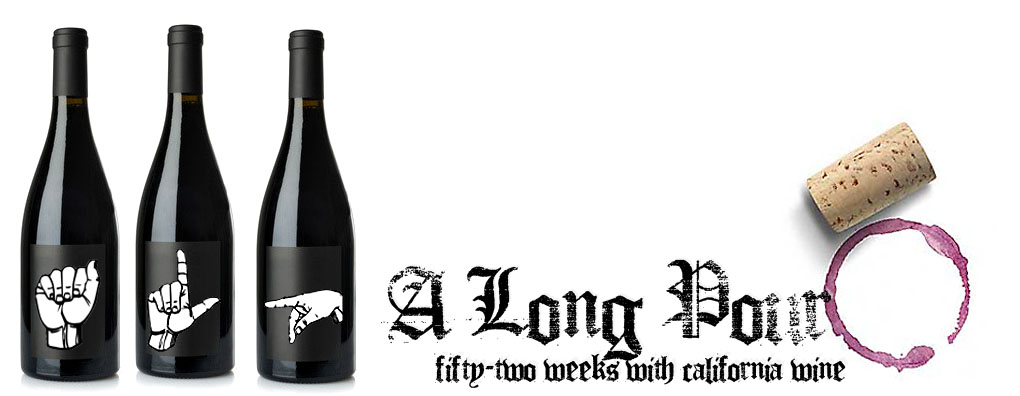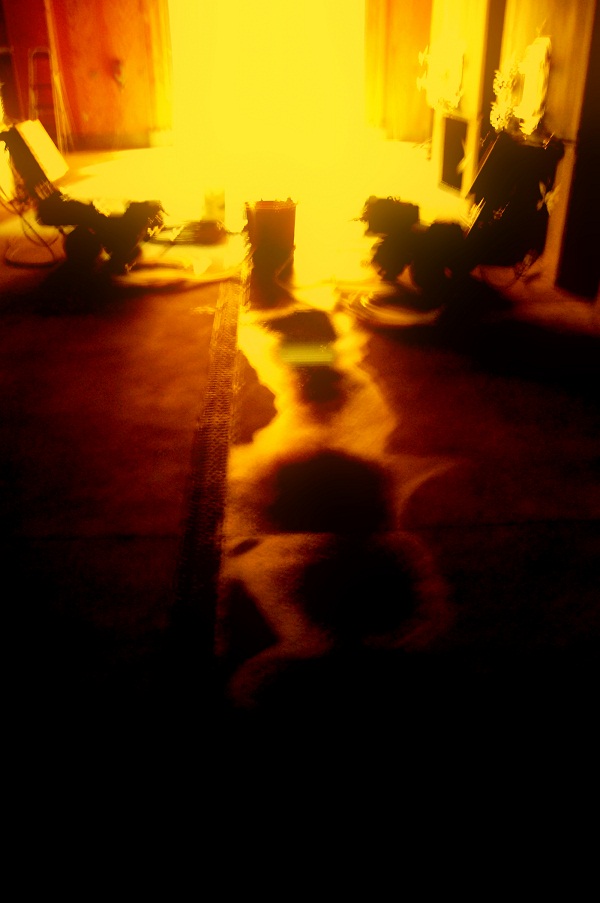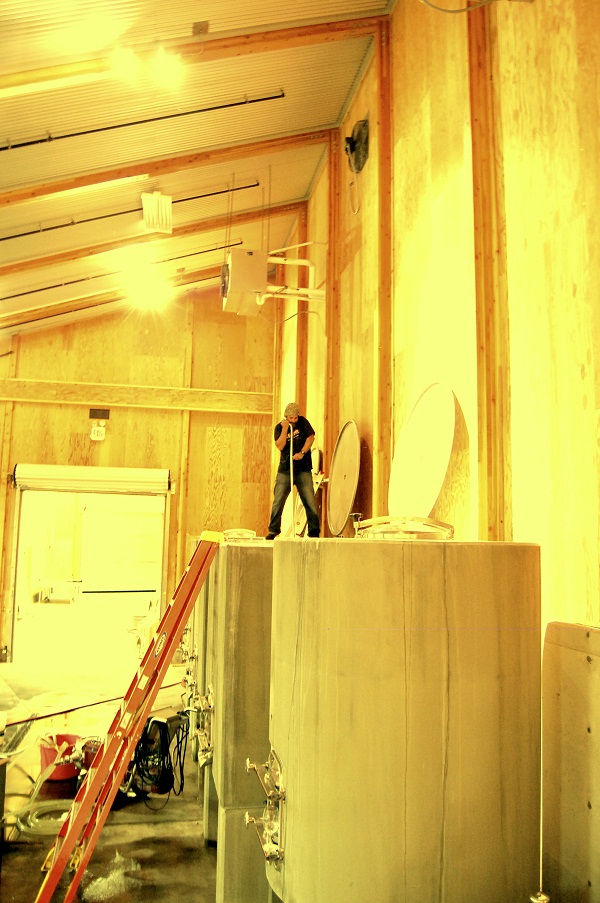Linne Calodo Part II {The Pieces}
So I got a tad gushy the other week about Matt Trevisan of Linne Calodo. I don’t regret it. Matt is a rather wonderful kind of a guy and one of the most impressive winemakers I know. But rather than recap all of the reasons we’re impressed with him (which are many and were well documented here), let’s just sum it up by saying: we like him.
Setting out to document what makes a winemaker is a daunting task. Sometimes the people we work with are well known, like Randall Grahm of Bonny Doon, a celebrity in his own right. In such a case, one can skip a deep treatise into the history of the winery and get right to something of interest, say marketing and why it is like crack cocaine. In other instances, the subject winery was relatively unknown to us prior to our visit with them, like Pfendler. In this case, you must first explain their story before you can explain the wine.
With Linne Calodo, it was a bit different. On the one hand, Linne Calodo and even Matt Trevisan, have become synonymous with one of the greatest wine movements in the United States. Still, in my research there wasn’t much in print on Matt, the person. When speaking with others within the industry about Matt, in advance of our visits, they had little more to offer than a few rumors and some nice accolades for his wines. People love the wine, but they didn’t seem to know much about Matt other than the fact he is “kind of quiet.”
So to tell the story of Linne Calodo, to help explain the wines by explaining Matt, I was forced to write a 3,000 word essay trying to get to the very core of who he is and why he does what he does. But this wasn’t enough. The manuscript was incomplete; it was lacking, it fell short. So I have necessity laid upon me to write a second part to further explain he whom I called a “genius.”
These stories can be tremendous work. I suspect more than 20 hours went into the writing of “Names Will Never Hurt Me.” That is many of hours of my life I will never get back and I hold Matt personally responsible for this. So, for my revenge, I present: “Nemesis – The ALP! True Paso Robles Story of Matthew Trevisan.”
U N D E R S T A N D I N G L I N N E C A L O D O . A. K. A. : W H A T I C O U L D N ’ T G E T A C R O S S I N 3 , 0 0 0 W O R D S , W H I C H K I N D O F M A K E S M E A B A D W R I T E R , I M E A N C O M E O N , W H O D R A G S T H I N G S O U T T H I S L O N G ?
P A R T I – F O U N D A T I O N S
“That first day, when you set the corner of a building and you know it’s going to be 150’ long, and you begin to move it, three feet this way, three feet that way, I love that day. But once you do it, it sets everything. If I don’t get my line right on it the two building’s corresponding angles are going to look awkward, or, they are going to look like they flow.”– Matt Trevisan on building his winery
When Matt first moved to San Luis Obispo to attend Cal Poly he lived in the dorms. While working at the campus radio station he saw an advertisement for “a room for rent.” It was the message that came with the ad that caught his attention. “Everything was OK at this house,” Matt recalled of the ad. “’Everything is OK here! Come hang out, we aren’t going to judge you!’ The place was a dive. I rented a room there and that’s where Justin (Smith of SAXUM) lived.”
Matt’s friendship with Justin lead to his first vineyard work.
“When [Justin’s family] had to pick, he would get a bunch of college guys and girls together. That was my first introduction to a vineyard, on this road (Willow Creek), carpooling with a bunch of guys and girls and sitting out there talking the whole day about…about…nothing. We were throwing clusters at each other at one point. I was so naive! I don’t throw fruit anymore, it’s worth something, so it’s not funny to throw clusters at people… unless it’s bad clusters and they are working slow,” he adds with a laugh.
“So that was my first time up and how I met Justin’s Parents. But I had no idea I would be in the industry [then].”
Matt worked other odd jobs through college including a stint in the Chemistry department. The husband of one of his supervisors worked in grower relations for Mondavi and she encouraged him to give some thought to the wine industry after he graduated.
Then, an entry position at JUSTIN Winery came available.
“I sent a resume to JUSTIN on a Friday and on Monday had a job there as an apprentice. Justin asked me if I knew how to drive a forklift and I said ‘I know how to fly a plane’ (he got his pilot’s license while still in school).” It was a task he would learn exceedingly well over the coming years.
The experience at JUSTIN was invaluable for Matt, who attributes much of the hands-on approach that is a trademark of Linne Calodo to his early experiences there. It was an exciting and exhausting time for him and he was regularly working 70 to 80 hours a week, driven in part by his insatiable desire to learn.
“I probably gained a bad attitude of sorts,” he explains, “only because I was really aggressive to learn whatever, and I was going to figure it all out. If you wanted me on the tractor, I would drive the tractor. If someone wasn’t doing a good job in the cellar or on the construction, I was going to go and do it right.”
P A R T I I – J U S T-A N E D U C A T I O N
Matt’s driven work ethic meant he was often the last employee at the winery.
“Justin and Debbie would have distributors coming in for dinner at night and I would still be there. They would say, ‘do you want to go to dinner with us tonight?’ So I would find myself sitting between Justin and Debbie. I was 21 years old and I felt like they would flick me on the ear if I said the wrong thing, but it was a huge learning experience for me.”
The Paso of Matt’s youth is not the Paso of today. Only a handful of wineries of note called Paso home and it was proprietors like Justin Baldwin and Matt’s latter employer, Ken Volk, who had to fight for their rightful place as one of America’s great terroirs. Through these dinners with distributors and other industry business men and women, Matt learned the importance of selling not just a product, but a place: Paso Robles.
But things are changing in sleepy Paso Robles, away from the pioneers who first realized the potential brilliance of the area. Away from those who first fought to build a name, for the region, and themselves. There are changes Matt has seen over his twenty years here.
“It seems it is transitioning out of that era,” he says, “where you have the bigger dollars coming in. They are buying the brand already existing and growing it into something even bigger. Or they are coming in with really deep pockets. Justin Baldwin, his original winery was underneath the bed and breakfast, underneath his house there. Ken Volk had a little barn in the back. .. it’s pretty cool how organic that growth was.”
Matt’s experiences while at JUSTIN taught him more than just building a brand and to work with his hands. There was the physical side of wine, learning about construction and winemaking, but there was also the business of wine and Matt knew that if he was to ever strike out on his own, he would have to have to understand the business of the industry as well.
“I was really technical,” Matt says of himself at the time. “I could understand winemaking, I could understand parts of growing grapes, but when I left JUSTIN I realized I needed to learn more about business.”
After Matt left JUSTIN and before he took a position at Wild Horse, he bought a longboard and moved back to Escondido with his parents. There he sat around surfing and reading the Wall Street Journal.
“Every morning I would wake up and buy a Wall Street Journal and try to figure out what was happening. I bought very technical financial books and market analysis text books. I came back up to [work at] Wild Horse and I would drive that forklift and I would sit there and read the Wall Street Journal. I did that because a friend of mine in college told me that there was a study done that found if you read the Wall Street Journal for three years it was the equivalent to a business degree. I still read it.”
P A R T I I I – T H E P I E C E S O F L I N N E C A L O D O
“The nice thing about my property is that it is this whole polyculture. You have oak trees and fruit trees, olives and grape vines. Then if you count my house garden, a garden by the barn, a garden below the house, gardens around the winery and one down by the front gate…there are all of these different places to have insects and keep the World balanced.”
I often use music to help me understand wine. Both offer something for everyone. Both can be controlled and manipulated so that they are perfect and soul-less, devoid of character. Both can be free and organic, brilliant in their imperfections.
Back when I still played with a group of guys, each instrument and therefore each musician was expected to provide his own component to the blend of sound (think Mogwai, Sigur Ros, Godspeed You! Black Emperor). It was for all purposes leaderless and there was no real front man. It was, if one can call it such a thing, organic, and the songs were not produced as much as they were allowed to become what it was they wanted to become. You can force music or you can listen to its underlying voice and respond appropriately.
Songs started with ideas, a few chords, a haunting melody. They were then cut and trimmed, expanded and paired with other pieces of music until we found just the right fit, the right components. As their parts came together, they began to breathe, to take on life. You stopped writing them and started responding to their organic nature, to what they were becoming.
One day, once it had all been arranged just so, and you had a chance to play these songs for others, what everyone experienced in that moment was not something static, but a living thing, an expression of art living through four musicians, each of them experiencing it in their own unique way. In that moment the music lived.
Those in the audience, who had not labored for months on any of it, had a very different experience than those who performed. Theirs was a much simpler connection, they either liked it or they didn’t. “I liked number two,” they would tell us. To them, it was just a good song, but to us it was “The Thief,” a song two years in its inception. It was a friend. In those songs lived every band practice that came before and every endless hour of their preparation. They were more than songs, they were personal stories, histories of our craft.
The best I can tell, this is what Matt’s wines are to him. They too started as an idea, a concept, but through a vintage they took shape, and in the cellar they started to develop a voice. For an outsider looking in, it can be hard to understand those deeper meanings, because they lack context. We weren’t there when their stories were formed, so we can never really know why they are what they are. A song is always bigger than its chords and a wine is always larger than the tasting notes. They are a life, a story, a history.
It is in part for this reason, the difficulty in explaining these personal details in a fast setting, that Matt chose to close his tasting room to the public last spring.
“When the tasting room got busy, you couldn’t sit them down and tell them what the difference in the wines was,” he explained.
“If they saw there was Grenache in this one, Syrah in that one, and Mourvèdre in that one, they right away assumed that they are all the same, Mourvèdre is Mourvèdre and Syrah is Syrah.” But to Matt, each wine was bigger than what it was on the surface, they were to him a collective story.
He continued, “I have 15 different vineyard blocks of Syrah, they are all on different soils, different slopes. Some face north, some face south, some face east, west, some are at the top if the hill, some are at the bottom. Then there are different mother clone plants and rootstocks and they all create a different flavor. When I put them all into my cellar and begin to think about blending, that’s where the flavors come from. Yes it’s Syrah, but to me they are all different and same thing goes for Grenache, Mourvèdre , and even Zinfandel.”
Just like a musician pulling in components to craft the perfect sounds, something compelling and soulful, the creation of a Linne Calodo wine relies on all the little parts. They are at the end an effort in patience, intellect, and time. They are more than wine #1 or #2, they are a story, a life. They are too deep to be understood in a moment.
Really, Matt says it best:
“I spend 8 months growing things and then I spend another 15 months maturing it in barrels. That’s a huge part of my life I’ve put into it when I’m making something that might only be 150 cases. It means a lot more to me than it does to them.”
P A R T I V – S A N S F O R M U L A
“Everyone has been brought up on the Coca-Cola idea or beer mentality, that all beers should be the same. It’s about replication. The wine industry is not about replication, it’s about making a new product and Mother Nature throwing all of these curve balls at you.”
By now, I’ve been thinking and writing about Matt for many weeks, since July actually. I don’t know if this is healthy or not, it probably isn’t, but it was the only way to sort it all out in some way.
The business of wine can seem so simple, to grow good grapes in good places, to watch over them, to guide them in the correct path. But there is so much more to it than a short paragraph of colorful words can ever express. You can’t tell the story of a winemaker and what it means to drive around the vineyard with his kids or to spend each and every day with their loyal dog in three sentences and two numerical digits. You just can’t. Winemakers are at their core (if they are good winemakers) students of the land, students of a topic that is in constant flux. They create a product that is in constant flux, a product that is influenced by their own taste and preferences; these too are in a constant flux.
You won’t find a formula scribbled on the walls of Linne Calodo. You won’t find a small group of people laboring at replication. Linne Calodo will remain about change, about flux, and about seeing a small corner of West Paso Robles through the eyes of a genius named Matt Trevisan.
{A N O T E O N T H E M U S I C}
In our last piece on Linne Calodo we included a few selections of music. These were chosen from bands I knew Matt likes or songs that reminded me of my time at Linne Calodo. Like many others, music helps me find a focus, a purpose in writing.
One song in particular was Mogwai’s Ratts of the Capital. I have loved this song for years, with its long beautiful burn and brutal crescendo. Being an older album of Mogwai’s, there are imperfections in it, things that I am sure they, as musicians, hear that no one else does. But the album and the song are perfect in their small flaws and in their passion. I came to realize that Ratts of the Capital represents what Linne Calodo is to me, the beautiful long burn of their history, the intense passion, all of it building towards an explosion of creative focus. Right now, from the way I see it, Matt and Linne Calodo are about minute 3:28. In other words, the best part is just starting.
Take a listen, maybe it will help you understand.







I know the man, I would say he is extremely focused but at the same time loose- like a good jazz artist. He listens to whats happening, or evolving around him. He knows his stuff too, from chemical analysis, oak grain, grape skin density etc…but he plays with what is possible with the wines. play it safe and get big scores…but no, he has to re-invent the wheel every year. He never pays attention to the mass consumption trends or marketing research groups, he is a one man show. He makes the wine with a single voice- (not a democracy). Lastly, he is funny, childish and easy going. You can really tell a lot about a winemaker on the mixed years (like 2006)… so if the past is any indication I can’t wait for 2010-2011- two of the screwiest years in some time.
Jericho, I would say you are right on about all of these statements. I like the Jazz comparison as well. As far as 2010-11, I have tasted through the 2010 LC’s and everything from 2011 (some of which was mostly juice still) and I can tell you quality is exceptionally high. There were a few stand out Zin lots I am curious to see what Matt does with in 2011 in terms of blending.